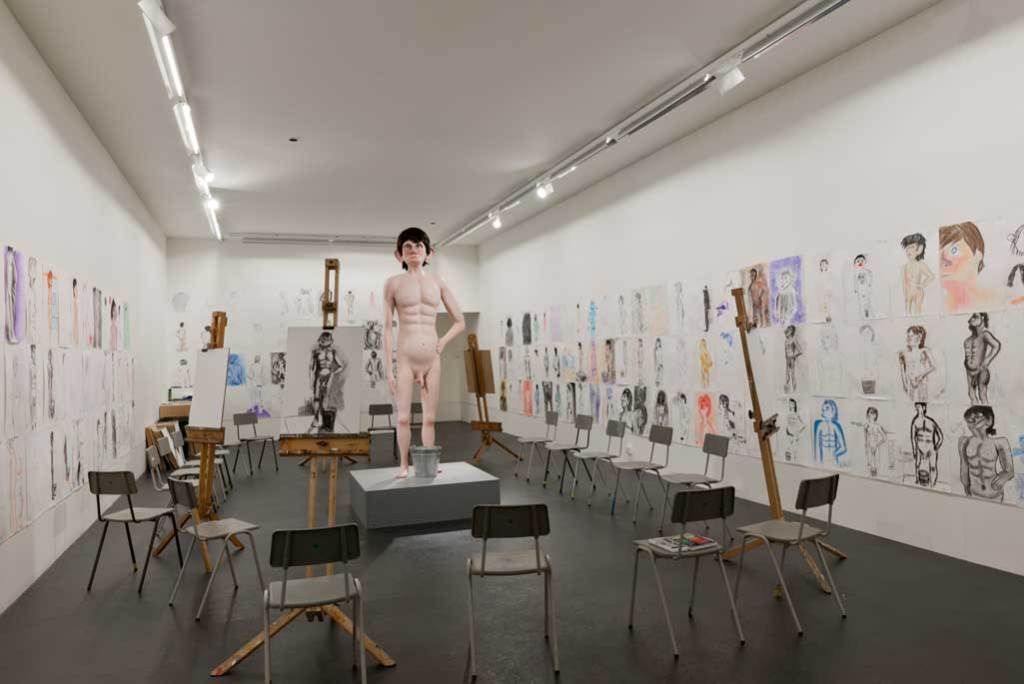Do you like David Shrigley? Of course you do. Everybody does. His drawings are interesting and distinctive; they’re a bit different, a bit creepy (in an ‘ironic’ way), and often quite funny. They’re absurdist, accessible and completely unmistakeable. This is why he’s popular; in art bookshops, in bourgeois drawing rooms, on mugs in student kitchens, Brand Shrigley is everywhere. He’s the Coca-Cola of mildly subversive Brit-Art, and more power to him – within reason.
This year, David Shrigley appears to have joined the major leagues. His Turner Prize nomination and proposal for Trafalgar Square’s Fourth Plinth have raised his idiosyncratic stock far beyond cult notoriety. The establishment (if there is such a thing in British art, then the Turner panel must surely embody it) has spoken. Gone are the days when one could momentarily glance at one of his doodles and think ‘oh, that’s quite clever’. Now you must study it, accord it all the fawning reverence due to Francis Bacon’s Studies after Velazquez, to which I recently heard someone who really should have known better compare a cartoon he published in The Guardian some years ago.
Value judgement and relativity in the discussion of art are either the preserve of reactionary snobbishness (‘What’s artistic about a dead shark?’) or post-modern pontification. If people like something, shouldn’t it be elevated to the pantheon? The question answers itself: Cliff Richard. Transformers. Nigel Farage. But this is to overdo the spuriousness; Shrigley is a first-rate cartoonist – but the Turner Prize?
This condescension does not stem from any perceived lack of gravitas on Shrigley’s part. ‘Serious’ art needn’t be entirely serious – in fact, a degree of wit informs all the best conceptual art. What it does require, though, is the capacity to intellectually transcend its physical form; it needs to tell us something about the way we live and who we are. Shrigley’s work doesn’t, at least not in any way that hasn’t been done to death before.
As you will know, he didn’t win the Turner – gratifyingly, the prize went to London-based French artist Laure Prouvost for Wantee, an imaginative and dazzling work that contained no shortage of humour itself. You can imagine Wantee – and, for that matter, Tino Sehgal and Lynette Yiadom-Boakye’s offerings – as works that might take on interesting new meanings in years to come. Not so Shrigley’s ‘Brain Activity’ show at the Hayward Gallery or the facile life-drawing class he put together for the exhibition in Derry.
The two works that have grabbed him the most attention this year – Fourth Plinth contender Really Good and the aforementioned, animatronic life-drawing class – are among the least interesting things he’s ever done. They don’t strike out particularly far from their grotesque physical forms and have none of the anarchic glee of his drawings or taxidermy. They were out of place in their respective line-ups, and not in a good way. Think Damien Hirst at the Wallace Collection. Think, for that matter, of cola at a champagne reception.
‘Self-contained’ is a gratuitously wielded term usually cracked out as a positive. There’s no doubt that it applies to Shrigley’s work, but here it only underlines the insularity of his corpus. It is, on its own terms, an impressive vision. But what does it say beyond the heroically infantile text he chooses to apply to it? Not much, I don’t think. Its power to divert is dependent on its ‘quirkiness’.
Shrigley may be a certifiable ‘national treasure’, but a great artist? You’re having a laugh.

